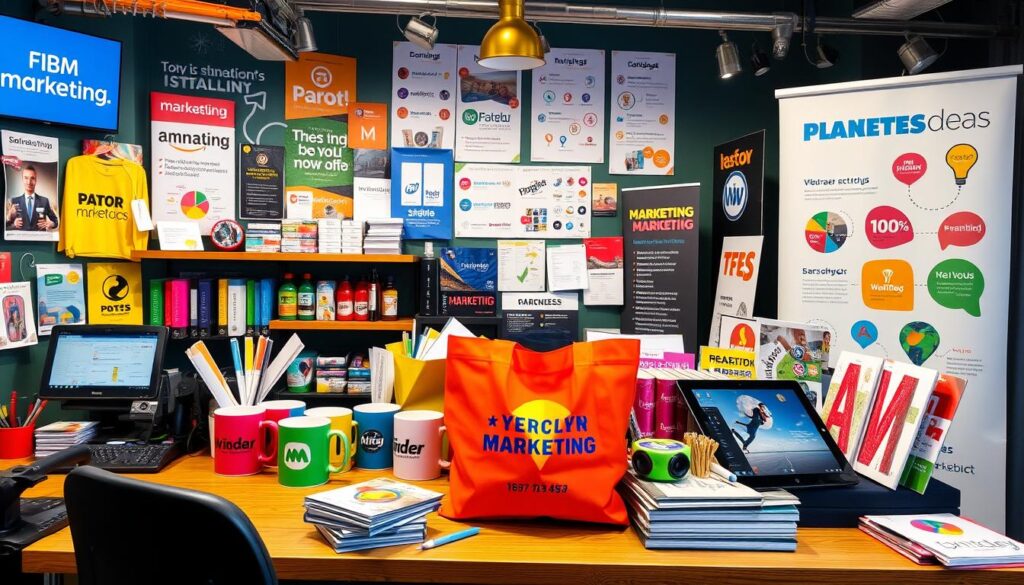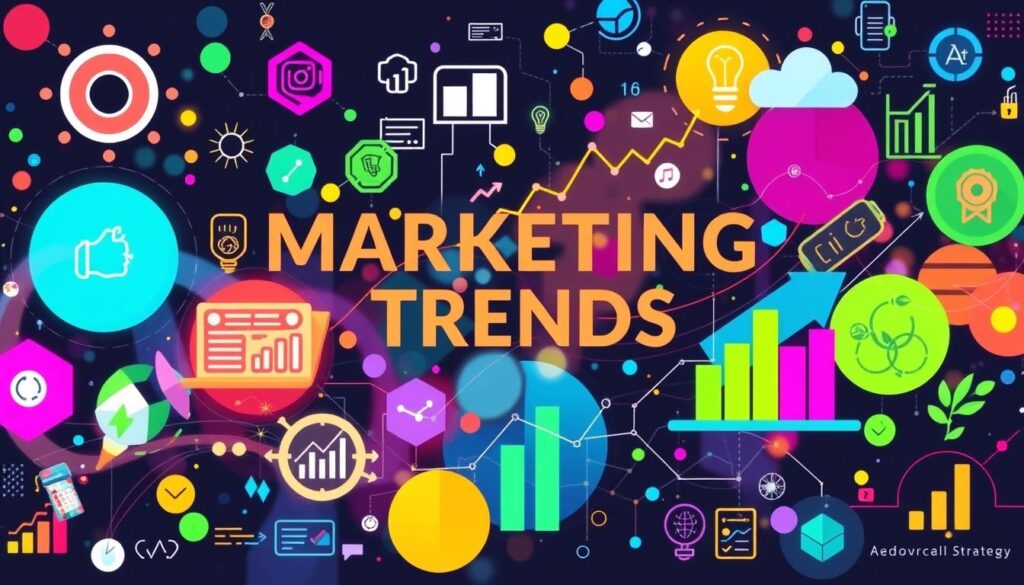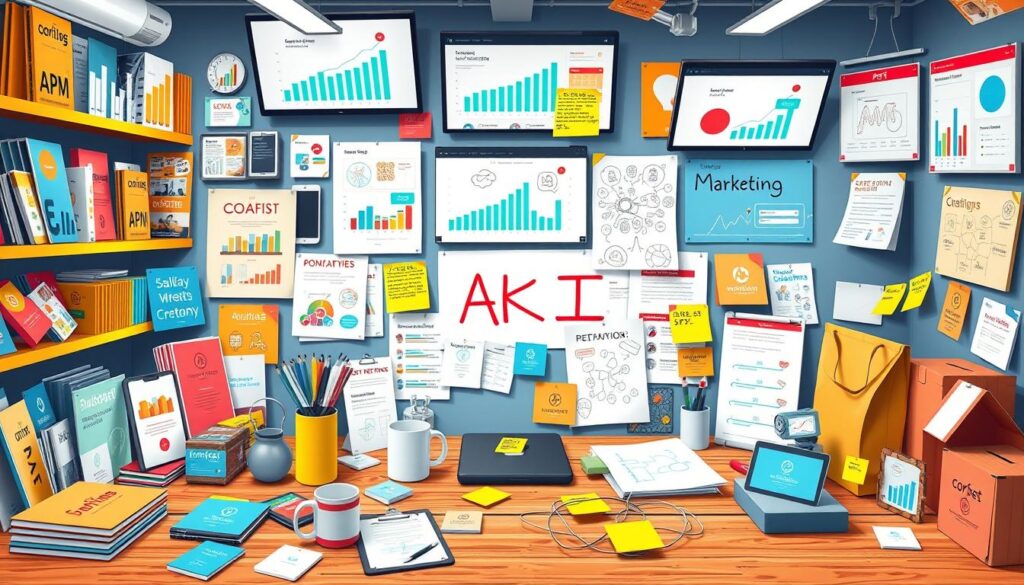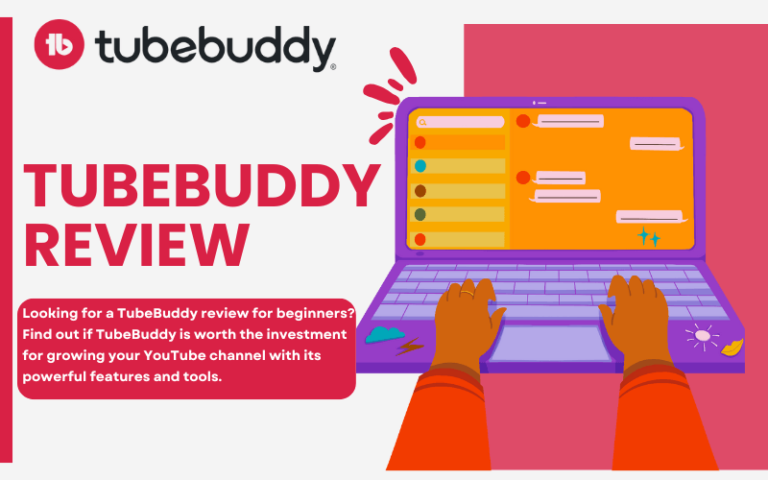In today’s fast-changing digital world, marketing can be tough. I’ve spent many late nights trying to figure out what works. I learned that the right tools are key to success.
As businesses fight for attention, the tools we choose matter a lot. They help us connect with our audience and grow our brand. Here, I’ll share the top 10 promotional marketing tools for 2025. They offer unique features and benefits to help us create winning sales promotions.
Key Takeaways
- Choosing the right promotional marketing tools is essential for effective marketing strategies.
- Over 60% of CMOs plan to invest heavily in AI for their marketing efforts in the coming years.
- Personalized experiences can increase consumer spending by up to 37%.
- Data privacy concerns are significant for consumers, impacting their buying decisions.
- Effective promotional tools can enhance brand awareness and increase sales significantly.
Introduction to Promotional Marketing Tools

Promotional marketing tools are key for any business wanting to promote its products or services well. They include digital and printed materials. Using these tools can boost my marketing and make my brand more visible. The right tools are essential for running successful campaigns.
It’s important to know about promotional marketing. The 4 Ps of marketing—product, price, place, and promotion—show where these tools help. Companies use strategies like advertising and direct marketing to share their brand message and engage with customers.
Advertising involves making choices about the message and where to share it. Sales promotions aim to increase sales quickly. Public relations help keep a brand’s image positive, and direct marketing cuts out middlemen for direct communication.
Here’s a look at key promotional tools that can improve my business:
| Promotional Tool | Function | Benefits |
|---|---|---|
| Advertising | Create brand awareness and generate leads | Effective reach across various media channels |
| Sales Promotion | Stimulate immediate consumer interest | Boost short-term sales and enhance product visibility |
| Public Relations | Maintain a positive brand image | Build trust and credibility with the audience |
| Direct Marketing | Establish communication directly with consumers | Targeted outreach and improved engagement rates |
Using these tools in my strategies helps me connect better with potential customers. With the right tools, I can make campaigns that boost visibility, improve brand image, and increase sales.
Marketing Trends in 2025 That Influence Tool Selection

Looking at marketing trends for 2025, some key points stand out. A big move towards AI in marketing is happening fast, with 73% of marketers using AI tools often. This shows a big push for technology that makes marketing better and helps customers more.
Also, searches for “AI marketing tools” have jumped up a lot, by 967% in two years. This shows a big interest in using AI to make marketing better. At the same time, making marketing personal has become very popular, with searches doubling in five years. This shows that 80% of people like it when marketing is made just for them, which is important for my business.
In social media, trends are also clear. TikTok, for example, has seen a huge jump in searches, up by 1,825% in five years. This shows it’s becoming a big place for promoting sales. Searches for “TikTok ads” have even gone up by 8,100%. This tells me I should think about using TikTok for marketing.
But there’s also a big worry about keeping customer data safe. Even though 90% of shoppers are okay with sharing info for a better deal, I need to be careful. As I deal with these changing trends, using AI and making marketing personal can help make my sales better.
Choosing the Right Promotional Marketing Tools for Your Business

Choosing the right marketing tools is all about understanding your strategy. Knowing what your audience likes is key to reaching them. It’s important to pick tools that fit your needs and goals.
Understanding Your Marketing Strategy
Knowing your marketing strategy is the first step. Look at who you want to reach and what you want to achieve. Analyze past campaigns to see what worked.
Using this information helps you pick tools that meet your needs. This way, you can improve your marketing and keep customers coming back.
Features to Look For in Tools
When picking marketing tools, look for certain features. These can help you meet your goals:
Automation and Efficiency
Automation is no longer a luxury—it’s a necessity in today’s fast-paced marketing world. Top tools in 2025 provide automated solutions for repetitive tasks, saving time and allowing marketers to focus on strategy.
Integration Capabilities
The best tools seamlessly integrate with existing systems, creating a unified strategy that improves workflow efficiency. Tools that allow cross-platform integration enable businesses to manage campaigns effortlessly.
Scalability for Growing Businesses
As your business expands, your tools should grow with you. Scalability ensures that your promotional marketing tools remain effective even as your operations and audience size increase.
Data-Driven Insights
Modern tools provide actionable insights from data analytics, helping businesses make informed decisions. From tracking campaign performance to predicting customer behavior, these insights are invaluable.
Top 10 Promotional Marketing Tools for 2025

Exploring the best promotional marketing tools for 2025 is key. I see the value in using different platforms to boost my marketing. Each type has its own strengths, from creating content to managing social media. Here’s a list of top tools to help take my marketing to the next level.
1. HubSpot Marketing Hub
HubSpot continues to lead the way in 2025, offering an all-in-one platform that simplifies inbound marketing. Its extensive features include email marketing, social media management, and comprehensive analytics.
HubSpot’s intuitive interface allows marketers of all levels to navigate with ease, while its seamless integration with other tools enhances overall efficiency.
Pricing for HubSpot starts with a free plan, but premium tiers like the Starter plan begin at $50 per month, scaling up to the Professional plan at $890 per month, and Enterprise options costing over $3,200 monthly, depending on the level of customization and features required. With its robust customer support and training resources, HubSpot remains a go-to choice for businesses aiming to scale their marketing efforts.
2. Canva Pro
Visual marketing takes center stage in 2025, and Canva Pro helps businesses create stunning graphics effortlessly. With its intuitive drag-and-drop editor and expansive template library, Canva Pro is a must-have for marketers who want to produce professional visuals quickly.
Canva Pro’s pricing starts at $12.99 per month for individual users, while teams can opt for the Pro plan at $14.99 per user per month. This affordable pricing makes it accessible for businesses of all sizes to enhance their visual marketing efforts without breaking the bank.
3. Hootsuite
Managing multiple social media accounts becomes a breeze with Hootsuite. Its advanced scheduling features and in-depth analytics provide marketers with the tools needed to optimize social media campaigns effectively.
Hootsuite offers flexible pricing plans, starting with a free plan for basic use. The Professional plan costs $49 per month, allowing management of up to 10 social accounts, while the Team plan at $129 per month supports collaborative efforts and up to 20 accounts. Enterprise solutions are available for larger organizations, with customized pricing to meet specific needs.
4. Semrush
Semrush is a favorite for its comprehensive SEO and competitor analysis tools. It helps businesses improve their online visibility, optimize content for search engines, and track the effectiveness of their digital strategies.
Semrush offers various pricing tiers to suit different needs. The Pro plan starts at $119.95 per month, designed for freelancers and startups, while the Guru plan at $229.95 per month is ideal for growing marketing teams. For larger enterprises, the Business plan is available at $449.95 per month, offering advanced features and customizable solutions.
5. Mailchimp
Email marketing continues to thrive, and Mailchimp leads the pack with its automation features and personalization options. The platform’s detailed performance analytics ensure that every campaign delivers results.
Mailchimp offers flexible pricing plans tailored to different business sizes. The Free plan is ideal for small-scale campaigns, while the Essentials plan starts at $13 per month, offering additional features like A/B testing. T
he Standard plan costs $20 per month, providing advanced automation and analytics, and the Premium plan, starting at $350 per month, is designed for larger enterprises with extensive marketing needs.
6. Google Analytics 4
Google Analytics 4 is the ultimate tool for understanding your audience. Its real-time tracking capabilities and robust reporting tools allow marketers to monitor and optimize campaign performance with precision.
Best of all, Google Analytics 4 is free for basic use, making it accessible to businesses of all sizes. For those with more advanced data needs, Google offers premium tiers through its Analytics 360 platform, starting at approximately $150,000 annually, tailored for enterprises requiring high-level customization and support.
7. Salesforce Marketing Cloud
Salesforce combines CRM and marketing automation to deliver unparalleled customer engagement solutions. The platform’s AI-driven personalization features make it a game-changer in 2025.
Salesforce offers a variety of pricing tiers to cater to businesses of all sizes. Its Marketing Cloud starts at approximately $400 per month for basic functionality, while more advanced packages tailored for enterprise-level operations can exceed $3,000 per month.
These plans provide access to robust analytics, customer journey mapping, and advanced AI features, ensuring businesses get maximum value for their investment.
8. Buffer
Buffer’s simplicity and efficiency make it a top choice for managing multiple social accounts. With features like post scheduling, engagement tracking, and detailed analytics, Buffer helps businesses maintain a strong online presence.
Buffer offers a range of pricing plans, starting with a Free plan that includes basic functionality for up to 3 social accounts. The Essentials plan is available at $6 per month per social channel, offering more features like analytics and unlimited scheduling.
For businesses needing advanced tools, the Team plan at $12 per month per channel supports collaboration, while the Agency plan at $120 per month caters to large-scale operations with multiple clients and accounts.
9. Asana Marketing Workflow
Collaboration and project management are vital for marketing teams, and Asana excels in this domain. Its task assignment, deadline tracking, and team collaboration tools streamline marketing workflows.
Asana offers flexible pricing plans to suit different team sizes and needs. The Basic plan is free and provides essential features for individuals and small teams. The Premium plan costs $10.99 per user per month and includes advanced search, timeline, and reporting tools.
For larger teams, the Business plan at $24.99 per user per month adds workflow automation and integrations with popular apps like Salesforce. Enterprises can opt for customized pricing to access enhanced security and support features.
10. Adzooma
Adzooma simplifies online advertising by enabling businesses to manage and optimize campaigns across platforms like Google and Facebook. Its AI-powered recommendations and automation features save time while boosting campaign performance.
Adzooma offers a free plan that allows users to manage three ad accounts, making it a great starting point for small businesses. For those requiring additional features, the Plus plan starts at $99 per month, offering unlimited ad accounts and advanced reporting.
Enterprise-level clients can benefit from customized pricing, which includes tailored solutions and dedicated support for managing large-scale advertising campaigns.
How These Tools Boost Brand Awareness and Sales

Promotional marketing tools are key to my strategy. They greatly increase brand awareness and sales. For example, content marketing platforms help me create engaging content for my audience. This leaves a lasting impression.
Email marketing solutions also boost visibility through personalized messages. Studies show these campaigns can convert leads into sales effectively.
SEO software is vital for reaching targeted audiences. It’s a cost-effective way to keep my brand in front of potential buyers. Neil Patel.com shares success stories of using content marketing and SEO to improve outreach.
Social media platforms are great for building communities. They help through micro-influencers and user-generated content. This builds deeper connections and expands my brand’s reach.
Consistent branding can increase revenue by up to 33 percent. It also boosts job applicant interest. This shows the many benefits of strong branding.
| Tool Type | Benefits |
|---|---|
| Content Marketing Tools | Engagement with tailored content, enhancing brand recognition. |
| Email Marketing Platforms | Increased visibility in search engines attracts targeted traffic. |
| SEO Tools | Community building and user engagement lead to loyal customers. |
| Social Media Management | Community building and user engagement leading to loyal customers. |
Effective website and landing page builders are essential. They help create professional sites that attract visitors. Analyzing user behavior helps me optimize my sales funnel.
These strategies work together to create impactful marketing campaigns. They enhance my brand’s presence in today’s competitive market.
Potential Impact of Promotional Marketing Tools on Your Customer Base

Using the right promotional marketing tools can really change how your customers see your brand. A study by the Promotional Products Association International found that 94% of people like getting these items. It makes your brand look better and builds a strong connection with your customers.
When you use targeted strategies, you’ll see big changes in how customers act. For example, 76% of people remember the brand name on a product they got. This shows that good marketing can make your brand stick in people’s minds.
These tools also let you see how well your campaigns are doing in real time. You can find out what works and make your marketing even better. For instance, 63% of people share these items with others, which helps your brand reach more people without spending more money.
Items like custom socks are great for making your marketing stand out. They’re good for many things, like trade shows and showing appreciation to your employees. Since 85.4% of people like getting something real instead of just emails, using these items might get you better results.
In short, using promotional marketing tools can make your brand more visible and build a loyal customer base. It can also lead to more sales and happier customers.
| Statistic | Percentage/Detail |
|---|---|
| Respondents keeping promotional items for over five years | 50% |
| Respondents who recall brand names on promotional items | 76% |
| Consumers preferring promotional products over marketing emails | 85.4% |
| Respondents who enjoy receiving promotional products | 94% |
| Customers who have passed along a promotional product | 63% |
| American businesses spending on promotional products annually | $20 billion |
Kindly Check out our Top 10 Best Email Marketing For Small Businesses.
Conclusion
Understanding the importance of promotional marketing tools has been key for my 2025 marketing strategy. With 80% of companies using various tools, it’s clear they boost brand awareness and sales. Tools like Mailchimp and Google Analytics help me track engagement and improve outreach.
Platforms like Hootsuite and YouTube are crucial for effective marketing. They let me schedule social media posts and analyze user engagement. This helps me manage my online presence better and stay connected with my audience.
Looking ahead, using these tools will be crucial. As I face new challenges and opportunities in 2025, staying up-to-date with technology will help me stay competitive. Using these tools well will be key to reaching my marketing goals and growing sales.
Frequently Asked Questions (FAQs)
What are promotional marketing tools?
Promotional marketing tools help businesses like mine promote their products or services. They include digital platforms, printed materials, and promotional products. These tools aim to increase brand awareness and boost sales.
How can I choose the right promotional marketing tools for my business?
To pick the right tools, I need to know my marketing strategy and audience. I should look for tools that are easy to use, fit my budget, and offer free trials. This helps me see if they work well for my business.
What marketing trends should I consider when selecting promotional tools for 2025?
For 2025, focus on AI, personalization, and data privacy. These trends mean I should tailor my marketing to meet changing consumer needs. This ensures my strategies stay relevant and effective.
How do promotional marketing tools improve brand awareness?
Good tools help me create engaging content and run smooth campaigns. They let me reach my audience through different channels. This way, I can share my brand’s message, engage customers, and build a strong presence.
What role do promotional giveaways play in my marketing strategy?
Promotional giveaways are key in my strategy. They create urgency, get people to interact with my brand, and build loyalty. Giving out products boosts visibility and strengthens customer ties.
Can promotional marketing tools affect my conversion rate?
Yes, the right tools can greatly improve my conversion rate. They help personalize experiences and optimize campaigns. This leads to more sales and a bigger customer base.
Which are some examples of promotional marketing tools I should consider for 2025?
For 2025, consider tools like Jasper and Grammarly for content. For email, look at Mailchimp and Constant Contact. SEO tools like Ahrefs and SEMrush are also important. Don’t forget social media tools like Hootsuite and Buffer.
How can I measure the success of my promotional marketing campaigns?
To check how well my campaigns do, use analytics and reporting tools. They let me see how things are going in real-time. This way, I can improve my strategies and get better results.
Which promotional marketing tool is best for small businesses?
Tools like Canva Pro, Mailchimp, and Buffer are excellent for small businesses due to their affordability, ease of use, and scalability.
How do I choose the right promotional marketing tool for my business?
Start by assessing your business needs, budget, and goals. Take advantage of free trials, and gather feedback from your team to ensure the tool aligns with your workflow.
Are there any free promotional marketing tools available?
Yes, many tools offer free versions or trials. For instance, Canva, Hootsuite, and Mailchimp provide free plans with limited features, allowing businesses to test their effectiveness before committing.





I truly appreciate your technique of writing a blog. I added it to my bookmark site list and will
Thank you so much! I’m really glad you enjoyed the writing style — that means a lot. 😊
I appreciate the bookmark! I hope you’ll check back often — there’s plenty more valuable content coming soon.
Awesome! Its genuinely remarkable post, I have got much clear idea regarding from this post
I really appreciate your kind words! 😊
I’m glad the post helped you get a clearer idea about the topic — that’s exactly what I aim for. Thanks for reading and for being part of the blog community!
Nice post. I learn something totally new and challenging on websites
Thank you for sharing your personal experience and wisdom with us Your words are so encouraging and uplifting
I appreciate you sharing this blog post. Thanks Again. Cool.
Your words carry such profound inspiration and wisdom. Reading this felt like a powerful affirmation and a gentle nudge in the right direction. Thank you for sharing such an uplifting message.
My deepest thanks to the author for crafting and sharing this outstanding piece of writing. It stands out for its thoughtful engagement with the topic and the impressive depth of its analysis. Truly a valuable contribution.
There is definately a lot to find out about this subject. I like all the points you made
Good post! We will be linking to this particularly great post on our site. Keep up the great writing
This was beautiful Admin. Thank you for your reflections.
This was beautiful Admin. Thank you for your reflections.
Nice post. I learn something totally new and challenging on websites
Very well presented. Every quote was awesome and thanks for sharing the content. Keep sharing and keep motivating others.
Great information shared.. really enjoyed reading this post thank you author for sharing this post .. appreciated
This is definitely going straight onto my “recommended reading” list for anyone I know with an interest in this field. It’s not just informative; it’s profoundly thought-provoking and offers tangible takeaways.
Very well presented. Every quote was awesome and thanks for sharing the content. Keep sharing and keep motivating others.
I just like the helpful information you provide in your articles
I very delighted to find this internet site on bing, just what I was searching for as well saved to fav
I really like reading through a post that can make men and women think. Also, thank you for allowing me to comment!
Great information shared.. really enjoyed reading this post thank you author for sharing this post .. appreciated
I am truly thankful to the owner of this web site who has shared this fantastic piece of writing at at this place.
Your blog is so much more than just a collection of posts It’s a community of like-minded individuals spreading optimism and kindness
Gorgeous! This has been an exceptionally great post. I sincerely thank you for supplying this information.
Very well presented. Every quote was awesome and thanks for sharing the content. Keep sharing and keep motivating others.
I very delighted to find this internet site on bing, just what I was searching for as well saved to fav
Hi there to all, for the reason that I am genuinely keen of reading this website’s post to be updated on a regular basis. It carries pleasant stuff.
Awesome! Its genuinely remarkable post, I have got much clear idea regarding from this post
This is exceptionally interesting. You are a talented blogger. I have joined your feed and am eager to see more of your fantastic posts. Also, I have shared your website on my social media channels!
You are exceptionally wonderful! I do not recall having read anything of this nature before. It is a pleasure to find someone with such creative ideas on this subject. Truly.. I appreciate you for kickstarting this conversation.
I really like reading through a post that can make men and women think. Also, thank you for allowing me to comment!
The information presented here is incredibly valuable. I appreciate the depth of exploration and the clear delivery of your ideas. It’s a fantastic resource for anyone interested in this area.
Your writing style is engaging and easy to follow. Keep it up!
Excellent article — the FAQs section was particularly useful.
Well-researched and balanced. Appreciate the effort behind this.
Hi there to all, for the reason that I am genuinely keen of reading this website’s post to be updated on a regular basis. It carries pleasant stuff.
Thank you so much for your kind words! 😊
I’m really happy to know you enjoy the posts and visit regularly. I’ll keep sharing more useful and interesting content — stay tuned for the next one!
I enjoyed the case study — it really brought the theory to life.
Helpful post — could you also share examples for beginners?
Great information shared.. really enjoyed reading this post thank you author for sharing this post .. appreciated
very informative articles or reviews at this time.
I like how Buddy is a fresh alternative to traditional social media.
Your blog has helped me become a more positive and mindful person I am grateful for the transformative effect your words have had on me
Insightful post — I’d be interested in a follow-up on advanced topics.
Your blog is a constant source of inspiration for me. Your passion for your subject matter is palpable, and it’s clear that you pour your heart and soul into every post. Keep up the incredible work!
This is a great resource! The information is well-organized and easy to understand. Thanks for sharing!
Excellent article! I’ll be sharing this with my network. Thanks for the valuable information.
I’ll be coming back to this article for reference. The information is so useful and well-presented.
Such a clear explanation — I feel more confident tackling this now.
This blog is such a hidden gem I stumbled upon it by chance and now I’m completely hooked!
Your writing style is engaging and easy to follow. Keep it up!
I am truly thankful to the owner of this web site who has shared this fantastic piece of writing at at this place.
Concise, practical, and to the point. Thanks for sharing.
This is a gem of a post. Simple yet effective advice.
This is my first time pay a quick visit at here and i am really happy to read everthing at one place
I very delighted to find this internet site on bing, just what I was searching for as well saved to fav
I do not even understand how I ended up here, but I assumed this publish used to be great
Your writing is a true testament to your expertise and dedication to your craft. I’m continually impressed by the depth of your knowledge and the clarity of your explanations. Keep up the phenomenal work!
There is definately a lot to find out about this subject. I like all the points you made
Good post! We will be linking to this particularly great post on our site. Keep up the great writing
Pretty! This has been a really wonderful post. Many thanks for providing these details.
This is my first time pay a quick visit at here and i am really happy to read everthing at one place
Nice post. I learn something totally new and challenging on websites